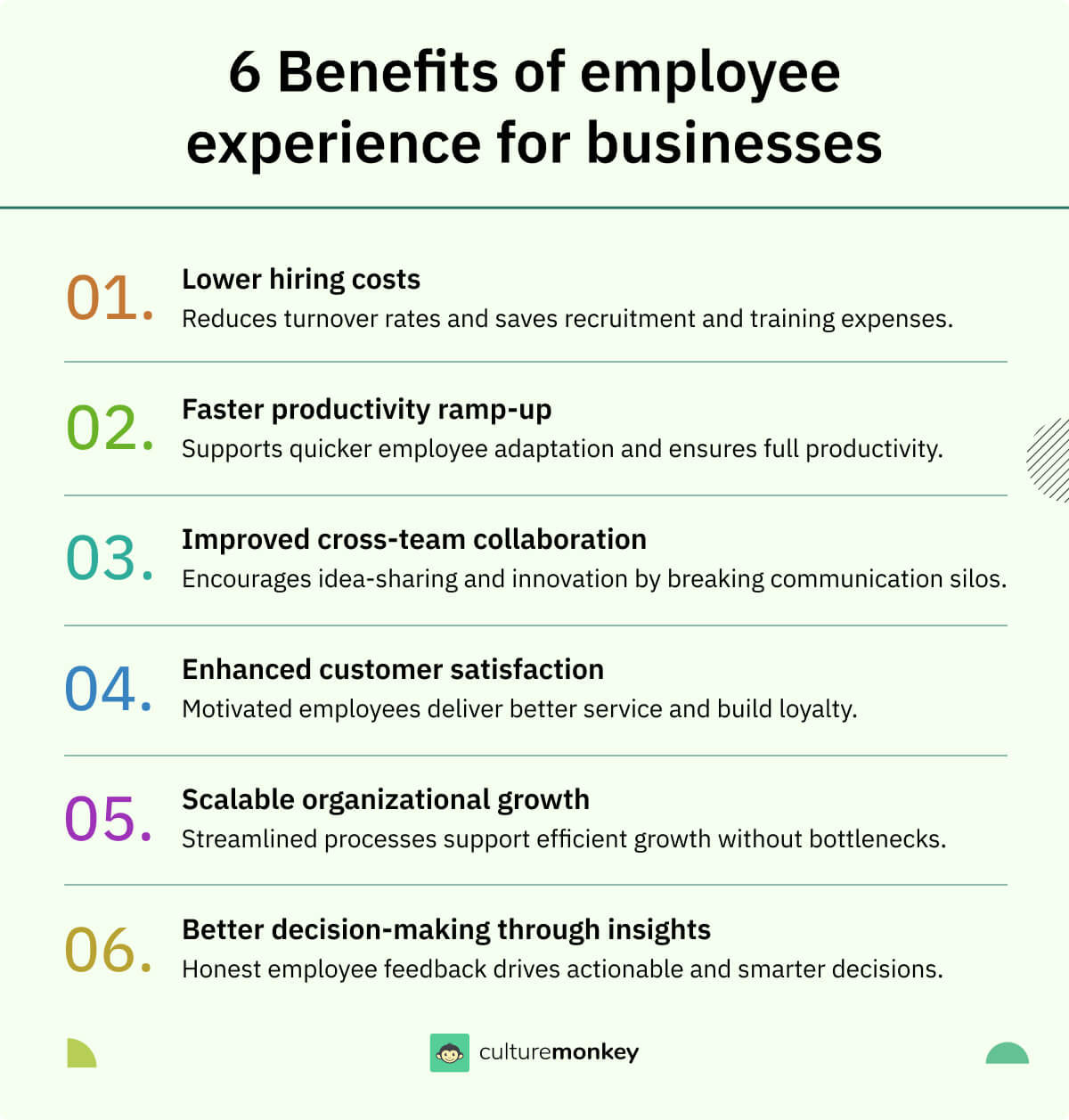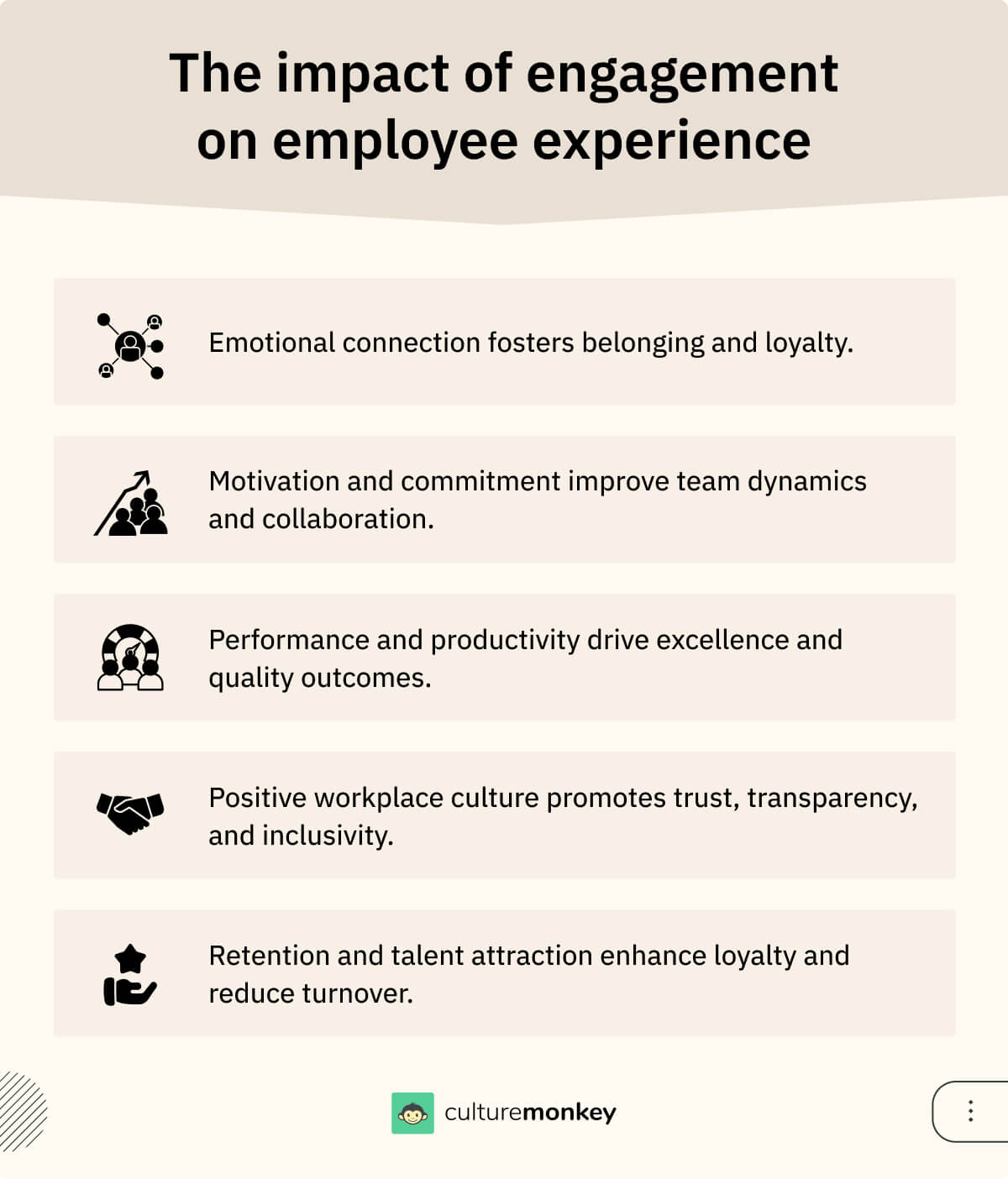Employee experience vs employee engagement: How HR leaders can drive growth and trust in 2025

Many organizations often confuse employee engagement with employee experience, treating them as interchangeable concepts. While engagement focuses on an employee's emotional connection to their work, experience encompasses the entire journey within the organization, from onboarding to offboarding.
Both are critical—engagement drives productivity and motivation, while experience ensures a supportive and fulfilling work environment. Neglecting one can undermine the other, affecting overall organizational success.
Learn why differentiating and leveraging both is crucial for success.
Blog Highlights


What is employee engagement?

Employee engagement is the emotional commitment and enthusiasm employees have toward their organization and its goals. It goes beyond job satisfaction and focuses on how invested employees are in their work, colleagues, and the company's success. Engaged employees bring energy, dedication, and passion to their roles, driving productivity and collaboration.
Unlike employee experience, which covers the entire employee journey, engagement reflects the emotional connection employees feel in the present. It’s influenced by factors like recognition, leadership, career development opportunities, and workplace culture. High employee engagement leads to improved retention, reduced absenteeism, and better customer satisfaction.
Organizations with engaged employees are more likely to innovate and outperform competitors, making employee engagement a crucial driver of sustainable business success.
What is employee experience?

Employee experience (EX) refers to the holistic journey employees take throughout their time with an organization. It encompasses every interaction, perception, and touchpoint—from recruitment and onboarding to daily work, career development, and eventually offboarding. Unlike employee engagement, which focuses on emotional connection, EX covers a broader spectrum, including work environment, tools and resources, organizational culture, and leadership support.
A positive employee experience ensures employees feel valued, supported, and empowered to perform at their best. It directly impacts retention, productivity, and morale, making it a critical component of organizational success. By investing in EX, businesses can foster loyalty, enhance employee satisfaction, and attract top talent. A seamless, meaningful employee experience drives both individual and organizational growth in today’s competitive workplace landscape.
Employee engagement vs employee experience: What’s the difference
In essence, while employee engagement is a crucial component of the overall employee experience, the latter encompasses a broader and more long-term perspective, addressing all aspects of the employee journey. Let’s take a look at the difference between the two.
| Aspect | Employee Experience | Employee Engagement |
|---|---|---|
| Scope | Encompasses the entire journey of an employee within the organization, considering every touchpoint from recruitment to offboarding | Refers to an employee's emotional commitment and connection to their job, team, and organization |
| Nature | Long-term perspective spanning an employee's entire tenure | Emphasizes enthusiasm, motivation, and dedication employees bring to their roles |
| Timeframe | Covers physical work environment, company culture, technology, work-life balance, learning opportunities, and more | Immediate and dynamic concept reflecting an employee's current emotional involvement , which can fluctuate over time |
| Elements included | involves gathering feedback through surveys, interviews, and assessments to evaluate various aspects of the employee journey | Focuses on emotional connection to work, colleagues, and the organization. Relates to motivation and willingness to excel |
| Measurement | Leads to higher engagement, attracts top talent, reduces turnover, and fosters a positive company culture | Typically measured through surveys that gauge engagement levels and job satisfaction at a specific point in time |
| Impact | Leads to higher engagement, attracts top talent, reduces turnover, and fosters a positive company culture | Associated with increased productivity, lower absenteeism, improved customer service, and other performance outcomes |
| Integration with HR practices | Integrates employee-centric practices into recruitment, onboarding, training, performance management, and offboarding to create a seamless journey | Focuses on initiatives like recognition programs, team-building, and feedback mechanisms to boost motivation and morale |
| Influence on organizational strategy | Shapes the employer brand and aligns with organizational mission, values, and objectives to create a compelling employee value proposition | More tactical and operational, addressing short-term interventions for morale and commitment issues |
| Emphasis on employee well-being | Prioritizes physical, mental, and emotional well-being, fostering work-life balance and overall wellness | Indirectly contributes to well-being by enhancing job satisfaction and driving productivity |
Employee engagement vs. employee experience: which should you prioritize?
Both employee engagement and employee experience are essential, but their importance depends on the organizational context and goals. Employee engagement focuses on how motivated and emotionally connected employees are to their work and the organization.
On the other hand, employee experience encompasses the entire journey of an employee within the organization, influencing every touchpoint from recruitment to exit.
While engagement drives immediate outcomes like productivity and performance, experience builds the foundation for long-term employee satisfaction and retention. A positive employee experience creates the conditions necessary for engagement to flourish.
Without a good experience—such as a supportive culture, streamlined processes, and proper tools—engagement efforts can feel superficial and unsustainable.
For organizations aiming for sustained success, the two must work in tandem. Employee experience lays the groundwork by creating an environment that fosters trust, inclusion, and growth. Engagement then capitalizes on this foundation by motivating employees to contribute their best efforts.
Therefore, neither is more important in isolation—they are two sides of the same coin, vital for holistic organizational success.
Employee experience vs. employee engagement benchmarks

Employee experience (EX) and employee engagement (EE) are vital aspects of an organization's success, and benchmarking these metrics can provide valuable insights into your workforce's well-being and productivity. Below are some common benchmarks for both EX and EE:
Employee experience (EX) benchmarks
- Onboarding completion time: Measure the average time it takes for new hires to complete the onboarding process. Benchmark against industry standards to ensure a smooth and efficient onboarding experience.
- Employee net promoter score (eNPS): Similar to the Net Promoter Score (NPS) used for customers, eNPS measures employees' likelihood to recommend your organization as a great place to work. A high eNPS indicates a positive EX.
- Workplace satisfaction surveys: Conduct regular workplace satisfaction surveys to gauge employee sentiments about their work environment, company culture, and overall experience. Benchmark results over time to track improvements.
- Retention rate: Calculate the percentage of employees who stay with your organization over a defined period. A high retention rate suggests a positive EX, as satisfied employees are more likely to stay.
- Learning and development metrics: Monitor metrics related to employee training and development, such as the number of training hours completed, the percentage of employees who participate in learning programs, and the impact of training on job performance.
- Diversity and inclusion metrics: Monitor key metrics related to diversity and inclusion, such as the representation of underrepresented groups, pay equity, and employee satisfaction across demographics. Benchmark against industry standards to ensure an inclusive and equitable workplace.
- Employee well-being initiatives: Track the effectiveness of well-being programs and initiatives, such as mental health resources, wellness activities, and work-life balance initiatives. Measure metrics like participation rates, satisfaction levels, and impact on employee stress and burnout.
- Internal mobility rates: Measure the percentage of employees who move to different roles or departments within the organization. A high employee engagement and internal mobility rate indicates opportunities for growth and development, contributing to a positive employee experience.
Employee engagement (EE) benchmarks
- Employee engagement survey scores: Conduct regular employee engagement surveys and use scores to benchmark your organization's engagement levels against industry benchmarks or competitors. Common engagement survey questions may include topics like job satisfaction, motivation, and alignment with company values.
- Manager-employee feedback: Track the frequency and quality of feedback and communication between managers and their direct reports. Higher levels of regular feedback often correlate with increased engagement.
- Absenteeism rate: Measure the rate of employee absenteeism, as engaged employees are less likely to take unplanned time off. Benchmark your organization's absenteeism rate against industry averages.
- Productivity metrics: Assess employee productivity through key performance indicators (KPIs) relevant to your industry. Compare your organization's KPIs to industry benchmarks to evaluate the impact of employee engagement on performance.
- Employee recognition programs: Track the utilization and impact of employee recognition programs, such as the number of recognitions given, the frequency of recognition, and the correlation between recognition and engagement levels.
- Employee turnover rate: Calculate the percentage of employees who leave the organization voluntarily. High turnover can indicate low engagement levels, so benchmark against industry averages to identify areas for improvement.
- Career development opportunities: Measure employees' perceptions of career advancement opportunities within the organization. Track metrics such as promotion rates, career development program participation, and satisfaction with growth opportunities.
Benefits of employee experience for business

A positive employee experience doesn’t just impact employees—it directly influences an organization’s performance and sustainability. By fostering a culture where employees feel valued and supported, businesses can unlock significant benefits across various operational areas. Here are six practical advantages:
- Lower hiring costs: A seamless employee experience reduces turnover, minimizing the need for frequent hiring and training. Retaining employees means businesses save on recruiting expenses while maintaining operational continuity.
- Faster productivity ramp-up: When onboarding processes are clear and supportive, employees reach peak productivity faster. An effective start to their journey ensures employees quickly adapt to their roles and begin contributing meaningfully.
- Improved cross-team collaboration: A positive work environment encourages collaboration by breaking silos. When employees feel comfortable sharing ideas, it leads to better communication and innovation across departments.
- Enhanced customer satisfaction: Happy employees create better customer experiences. A motivated workforce is more likely to deliver exceptional service, directly improving customer loyalty and retention.
- Scalable organizational growth: An optimized employee journey allows businesses to scale efficiently. Clear workflows, structured feedback systems, and supportive tools enable the workforce to grow without bottlenecks.
- Better decision-making through insights: Happy and engaged employees provide honest feedback, offering actionable insights into organizational strengths and weaknesses. These insights drive smarter, more impactful decisions.
How improving employee experience can boost engagement

Employee engagement thrives on the foundation of a positive employee experience. When employees feel valued, supported, and equipped to succeed, their emotional commitment and motivation naturally increase.
By focusing on the employee experience, organizations can address the factors that directly influence engagement, creating an environment where employees feel both connected and empowered.
A well-rounded and modern employee experience starts with a seamless onboarding process. When employees are welcomed with clarity, support, and access to necessary tools, they feel confident and ready to contribute. This sets the tone for sustained staff engagement and experience..
The physical workspace also plays a pivotal role. Understanding how the physical workspace impacts the employee experience can help organizations create an environment that promotes inclusivity, work-life balance, and professional growth. Access to user-friendly technology and resources further enhances the day-to-day experience, reducing friction and enabling employees to focus on their work.
Recognition and feedback are also critical components of the employee experience. Regular acknowledgment of achievements and constructive feedback help employees feel valued and motivated. Offering opportunities for learning and career advancement further deepens their connection to the organization.
By investing in the employee experience, companies can create a supportive ecosystem where employees are not just satisfied but genuinely engaged, driving both individual and organizational success.
Employee engagement experience examples

Employee engagement experience examples showcase the various ways organizations can foster a positive and impactful workplace environment that promotes employee satisfaction, productivity, and retention. Here are some examples of employee engagement experiences:
Recognition and appreciation programs
Implementing employee recognition programs is a powerful way to boost engagement and morale within the workforce. For instance, organizations may recognize employees for their outstanding performance, contributions to team success, or demonstration of company values.
This could include public acknowledgment during team meetings, awards ceremonies, or personalized notes from leadership. Such recognition not only rewards employees for their efforts but also reinforces a culture of appreciation and respect, enhancing the overall employee experience.
Opportunities for professional development
Providing employees with opportunities for continuous learning and growth is another effective way to drive engagement. This could involve offering access to training programs, workshops, conferences, or tuition reimbursement for further education.
Additionally, organizations can facilitate mentorship or coaching relationships to support employees in their career advancement goals.
By investing in employees' professional development, organizations demonstrate their commitment to nurturing talent, empowering individuals to reach their full potential, and fostering a culture of continuous learning and improvement.
Employee wellness initiatives
Prioritizing employee well-being is essential for promoting engagement and overall job satisfaction. Organizations can implement various wellness initiatives to support employees' physical, mental, and emotional health.
Examples include offering flexible work arrangements, promoting work-life balance, providing access to wellness programs or resources, and organizing stress-relief activities such as yoga classes or mindfulness sessions.
By prioritizing employee wellness, organizations demonstrate care and concern for their employees' holistic well-being, creating a supportive and healthy work environment conducive to engagement and productivity.

Retain Top Talent with a Better Employee Experience
Drive meaningful change with an employee experience strategy that improves retention and productivity.
Importance of mapping the employee journey in an organization

Mapping the employee journey in an organization is a strategic practice that involves understanding and visualizing what employees experience throughout their lifecycle within the company. It's a critical process for business leaders for several reasons:
Enhanced employee experience
Mapping the employee journey allows you to identify pain points, gaps, and opportunities for improvement throughout the employee's lifecycle. By addressing these areas, you can ensure that no one has a poor employee experience.
A better employee experience leads to higher job satisfaction, increased retention rates, and improved overall morale.
Improved onboarding and integration
The initial stages of the employee journey, including recruitment and onboarding, are crucial for setting the tone for an employee's entire tenure.
By mapping these early stages, you can ensure new hires receive a warm welcome, clear guidance, and the necessary resources to become productive quickly. This, in turn, reduces time to proficiency and boosts engagement with new employees from day one.



Employee experience has become a critical element of the work experience as employees believe (find meaning), become (learn and grow), and belong (connect with others). Employee experience is a lead indicator of customer experience and investor confidence.
Co-Founder and Principal
The RBL Group
Identifying pain points and gaps
Employee journey mapping allows you to uncover pain points and gaps in processes, communication, or support systems. This helps you proactively address issues that may be causing frustration or hindering productivity.
For example, if employees often struggle with a particular software tool during their journey, you can invest in training or seek a more user-friendly alternative.
Increased employee engagement
A well-mapped employee journey considers the factors that influence employee engagement, such as opportunities for skill development, feedback, and recognition.
Understanding these touchpoints allows you to design strategies to enhance engagement at critical moments in the journey. Engaged employees are more likely to be motivated, committed, and satisfied in their roles.
Enhanced organizational performance
Mapping the employee journey isn't just about improving individual employee experiences though; it can also significantly impact overall organizational performance. Employees who have a positive journey and feel supported at every stage are more likely to contribute to the company's success.
This includes increased productivity, higher customer satisfaction (as engaged employees provide better customer service), and a stronger company culture.
How engagement influences the employee experience?

Engagement significantly influences the overall employee experience, playing a pivotal role in shaping perceptions, attitudes, and behaviors within the workplace environment. Here's how engagement influences the employee experience:
- Emotional connection: Engaged employees develop a strong emotional connection to their work, colleagues, and organization. This sense of connection fosters a deeper sense of belonging and loyalty, enhancing the overall employee experience.
- Motivation and commitment: Engaged employees exhibit higher levels of motivation and commitment to their roles and organizational objectives. Their enthusiasm and dedication positively impact team dynamics, productivity, and collaboration, contributing to a more fulfilling and rewarding employee experience.
- Performance and productivity: Engaged employees are more likely to perform at their best and consistently strive for excellence in their work. Their heightened sense of purpose and intrinsic motivation drive higher levels of productivity, efficiency, and quality outcomes, enriching the employee experience for themselves and their peers.
- Positive workplace culture: Employee engagement contributes to the cultivation of a positive workplace culture characterized by trust, transparency, and open communication. Engaged employees actively participate in shaping the culture by embodying core values, fostering mutual respect, and promoting a supportive and inclusive environment conducive to growth and development.
- Retention and talent attraction: A positive employee experience fueled by engagement enhances retention rates and attracts top talent to the organization. Engaged employees are more likely to remain with the company, reducing turnover costs and preserving institutional knowledge.
Difference between employee engagement and job satisfaction

Employee engagement and job satisfaction are two crucial aspects of employee well-being and organizational success, yet they represent distinct concepts with unique implications for the workplace environment.
Understanding the differences between them is essential for effective talent management and fostering a positive organizational culture.
| Aspect | Employee Engagement | Job Satisfaction |
|---|---|---|
| Definition | Refers to the emotional commitment and connection an employee has toward their job, team, and organization | Pertains to an individual's contentment and fulfillment with various aspects of their job, including tasks and compensation |
| Scope | Encompasses a broader range of factors, such as organizational culture, leadership effectiveness, and alignment with values | Focuses on individual perceptions of specific job-related factors, such as tasks, pay, and environment |
| Dynamics | A dynamic and ongoing process that can fluctuate over time due to changes in leadership, culture, or team dynamics | Tends to be more stable and less influenced by short-term changes, driven by personal perceptions |
| Measurement | Typically measured through surveys or assessments evaluating emotional connection and commitment levels | Assessed through surveys or questionnaires focusing on satisfaction with compensation, work-life balance, and relationships |
| Management approach | Requires a proactive approach to foster a supportive environment , open communication, and employee recognition | Involves addressing specific areas of concern identified through feedback to improve the job experience |
How to measure employee engagement to improve employee experience?

Measuring employee engagement is a critical step in improving the overall employee experience within an organization. When you understand how engaged your employees are, you can identify areas for improvement and take targeted actions to enhance their experience.
Here are steps on how to measure employee engagement to improve employee experience:
- Select or create an engagement survey: Choose or design an employee engagement survey that suits your organization's specific needs. Ensure that the survey includes questions related to various aspects of the organization's employee experience, such as job satisfaction, work-life balance and more.
- Anonymity and trust: Ensure that the survey is anonymous and that employees trust their responses will remain confidential. This encourages honest feedback and prevents employees from fearing repercussions for providing candid opinions.
- Administer the survey: Distribute the survey to all employees, making it easily accessible through online platforms or printed forms. Consider using survey software to streamline data collection and analysis.
- Set clear objectives: Define the specific goals and objectives for the survey. Are you looking to identify areas of improvement in communication, leadership, or work-life balance? Having clear objectives will help you interpret the survey results effectively.
- Analyze the results: Once the survey is completed, analyze the results to identify trends, patterns, and areas with the lowest engagement scores. Pay attention to areas where employee feedback indicates dissatisfaction or disengagement.
- Segmentation: Segment the survey data by department, job role, or other relevant factors to gain a deeper understanding of where engagement varies within the organization. This can help you tailor interventions to specific groups.
- Seek qualitative feedback: In addition to quantitative survey data, gather qualitative feedback through focus groups, one-on-one interviews, or open-ended survey questions. Qualitative insights can provide context and clarity to the survey results.
- Share results and action plan: Communicate the survey results transparently to employees, acknowledging the positive aspects and areas needing improvement. Discuss the action plan for addressing identified issues and share the responsibility for improvement with employees.
- Implement interventions: Develop and implement targeted interventions based on the survey findings. These interventions may include changes in leadership training, improvements in communication strategies, enhanced recognition programs, or adjustments to work-life balance policies.
- Track progress: Continuously monitor and measure employee engagement and experience over time to assess the impact of your interventions. This ongoing feedback loop allows you to make necessary adjustments and improvements as needed.
How to design survey questions to accurately measure employee engagement
Organizations often ask generic or poorly structured survey questions, which can lead to inaccurate insights and ineffective action plans. Understanding the difference between employee engagement and employee relations is critical when designing surveys that address engagement drivers. Misaligned questions fail to address key drivers of engagement and leave employees feeling unheard.
Designing survey questions the right way ensures meaningful insights that drive targeted improvements and meaningful organizational change. Here are 7 components of effective survey question design:
Clarity and simplicity
Survey questions should be straightforward and easy to understand to avoid misinterpretation. Complex or ambiguous wording can confuse employees and result in inaccurate responses, skewing the overall insights. By focusing on clarity, organizations ensure that employees can quickly grasp the intent of the question and provide honest feedback.
Sample question: "Do you clearly understand your role and responsibilities at work?"
This question directly addresses a core element of engagement - role clarity, without unnecessary complexity.
Relevance to engagement drivers
Questions must align with factors that directly impact engagement, such as recognition, career advancement, and workplace relationships. Irrelevant questions dilute the effectiveness of the survey and waste employees' time. Relevant questions help uncover actionable insights that address the most critical aspects of engagement, ensuring the survey drives meaningful outcomes.
Sample question: "Do you feel recognized for your contributions at work?"
This question taps into the critical engagement driver of feeling valued, which directly affects motivation and retention.
Avoiding leading or biased phrasing
Leading or biased questions can influence employees' responses, resulting in unreliable data that doesn’t reflect their true sentiments. Neutral phrasing ensures objectivity, encouraging employees to share honest opinions. By eliminating bias, organizations can trust that their survey results are accurate and actionable.
Sample question: "Do you feel supported by your manager in achieving your goals?"
This question avoids assumptions and invites an unbiased assessment of managerial support.
Specificity over generalization
General questions often lead to vague responses that lack actionable insights. Specific, targeted questions help organizations pinpoint precise areas of strength or concern. This approach allows HR teams to focus their efforts on the areas that matter most to employees.
Sample question: "Do you have access to the tools and resources you need to perform your job effectively?"
This question zeroes in on a tangible engagement factor, access to resources, providing actionable insights for improvement.



Employee experience doesn’t need to replace engagement. The two can actually work together, and in fact, they have to
Founder
Future Of Work Leaders
Use of scalable rating systems
Employing rating scales, such as a Likert scale, quantifies employee sentiment and facilitates trend analysis over time. Rating systems make it easier to compare responses across teams or departments and identify areas requiring intervention. Quantified data also provides a clear baseline for measuring improvements.
Sample question: "On a scale of 1-5, how satisfied are you with the opportunities for career development?"
This allows employees to express varying levels of satisfaction, providing richer insights than a simple yes/no format.
Open-ended follow-ups
While closed-ended questions provide quantifiable data, open-ended questions offer qualitative insights that reveal the context behind employee responses. They allow employees to express their unique perspectives, share concerns, and suggest improvements, making the feedback more comprehensive.
Sample question: "What changes would improve your overall experience at work?"
This encourages employees to provide detailed feedback, uncovering actionable suggestions that may not be captured in closed-ended questions.
Regularly updated questions
Organizations are dynamic, and so are the factors influencing employee engagement. Survey questions must be reviewed and updated regularly to remain relevant to evolving workplace conditions and priorities. Outdated questions fail to capture current issues, reducing the effectiveness of the survey.
Sample question: "Has your workload changed in a way that impacts your engagement over the past quarter?"
This question addresses recent changes, ensuring the survey reflects current employee sentiments and challenges.
How to shape the employee experience of the modern workplace, the right way?

Shaping the employee experience in the modern workplace is a strategic imperative for organizations aiming to attract, retain, and engage top talent. To do it right, organizations must adopt a holistic approach encompassing various facets of the employee journey.
- Encourage open communication and active listening: A workplace culture of trust and transparency thrives on clear communication. Actively listening to employees ensures their voices are heard and valued, which strengthens trust and creates a collaborative environment.
- Prioritize continuous learning and development: In a fast-paced modern workplace, employees need opportunities for skill enhancement and career growth. Providing training programs, mentorship opportunities, and clear career paths helps retain talent and keep employees motivated.
- Provide access to mentorship and career advancement: Supporting employees with mentorship programs and well-defined career growth plans enhances their experience. Employees who feel supported in their professional development are more likely to remain loyal and perform better.
- Support work-life balance: Flexible work arrangements, such as remote work options or flexible schedules, reduce stress and help employees balance their personal and professional lives. A balanced employee is more productive and less prone to burnout.
- Offer regular feedback and recognition: Constructive feedback helps employees improve their performance, while timely recognition boosts morale. A structured feedback and recognition process ensures employees feel appreciated, supported, and motivated.
- Leverage technology to streamline processes: Providing employees with user-friendly tools and technologies simplifies their workflows and reduces frustration. By enabling employees to perform tasks efficiently, technology enhances their overall experience.
9 Strategies to create a positive work culture in 2025

A positive work culture is vital for employee engagement, retention, productivity, and innovation. It enhances job satisfaction, fosters teamwork, and contributes to a healthier work environment, resulting in happier employees who are motivated to excel and stay committed to the organization.
Here are 9 strategies that will help improve your organization’s work culture.
- Prioritize inclusivity: Cultivate a workplace where diversity is celebrated and all voices are heard and valued. Implement inclusive policies and practices to ensure equal opportunities for everyone.
- Foster communication: Establish a culture of open and transparent communication. Encourage regular feedback, town hall meetings, and platforms for employees to voice their opinions and concerns.
- Flexible work arrangements: Embrace flexibility by offering remote work options and flexible schedules. Trust your employees to manage their time effectively, promoting work-life balance.
- Continuous learning: Invest in employee development with ongoing training, mentorship programs, and clear career paths. Support employees in acquiring new skills and advancing in their careers.
- Recognize and reward: Implement a robust recognition program to acknowledge and reward employee contributions. Celebrate achievements publicly, fostering a culture of appreciation and motivation.
- Promote well-being: Prioritize employee well-being by offering mental health resources, wellness programs, and initiatives that reduce stress and promote a healthy work-life balance.
- Empower leadership: Develop and empower leaders who lead by example, demonstrate empathy, and champion the organization's values. Strong leadership sets the tone for a positive culture.
- Embrace technology: Leverage technology to streamline work processes, enhance collaboration, and improve productivity. Invest in user-friendly tools that make work more efficient.
- Value feedback: Encourage a culture of continuous improvement by valuing and acting upon employee feedback. Regularly solicit input and involve employees in decision-making processes to boost engagement and ownership in the company's direction.
What is the employee experience framework?

The employee experience framework is a strategic blueprint to measure employee experience and improve workplace interactions. It supports an employee engagement strategy by addressing key elements like onboarding, culture, and growth opportunities.
This framework ensures a positive, fulfilling journey for employees, enhancing their satisfaction and commitment throughout their tenure with the organization. Here are the key components of an effective employee experience framework:
- Pre-employment stage: This stage focuses on attracting top talent to the organization by effectively communicating the employer brand, values, and culture through recruitment marketing efforts, employer branding initiatives, and engaging job descriptions.
- Onboarding process: A structured onboarding process sets the tone for the employee's experience from the outset. It involves welcoming new hires, providing necessary training and resources, introducing them to the company culture, and clarifying expectations to ensure a smooth transition into their roles.
- Workplace environment: Creating a supportive and inclusive workplace environment is essential for fostering employee engagement and satisfaction. This involves designing physical workspaces that promote collaboration, providing access to necessary tools and resources, and cultivating a culture of respect, diversity, and inclusion.
- Learning opportunities: Offering opportunities for continuous learning and skill development is vital for employee growth and retention. Organizations can provide access to training programs, workshops, mentorship opportunities, and career advancement paths to support employees' professional development goals.
- Communication and feedback mechanisms: Effective communication channels and feedback mechanisms facilitate open dialogue between employees and leadership, fostering transparency, trust, and engagement.
Conclusion
Businesses that understand and act on the difference between employee engagement and employee experience gain a distinct competitive advantage. By focusing on employee experience, they create an environment that fosters trust, growth, and satisfaction throughout the employee lifecycle.
This foundation paves the way for higher engagement, where employees are motivated, connected, and invested in the organization’s success.
Together, engagement and experience drive productivity, innovation, and retention. Organizations that balance both are better equipped to adapt to challenges, attract top talent, and cultivate a thriving culture. Success lies in aligning these two concepts to fuel sustainable growth and long-term success.
Summary
Understanding the differences between employee experience and engagement is crucial for building a motivated and productive workforce. A positive employee experience enhances retention, collaboration, and satisfaction, while strong employee engagement fosters emotional commitment and performance.
Together, they drive better business outcomes, cultivate a thriving workplace culture, and ensure long-term organizational success. Investing in both creates a foundation for sustainable growth.
FAQs
1. What's the difference between employee experience and employee satisfaction?
Employee experience encompasses an employee's entire journey, considering culture, development, and all interactions, while satisfaction focuses on contentment at a specific point. EX aims for a fulfilling career and employee lifecycle, fostering long-term growth, whereas satisfaction gauges happiness with current conditions. Both are essential for fostering highly engaged employees and driving better business outcomes.
2. How can organizations maintain a positive work culture in remote work setups?
Maintaining a positive remote work culture involves clear communication, regular virtual check-ins, and fostering a sense of belonging through online team-building activities. Employers must trust employees to manage their schedules and make sure they prioritize work-life balance. Encouraging work-life balance and aligning with the organization's values ensures highly engaged employees who contribute to better business outcomes in a remote setting.
3. What role does leadership play in shaping a positive work culture?
Leadership plays a critical role in fostering a positive work environment. Effective leaders demonstrate empathy, transparency, and align with the organization's values, setting the tone for culture. Their actions directly influence employee morale, well-being, employee engagement, and the overall employee experience, creating the foundation for highly engaged employees and improved business outcomes.
4. How can small businesses with limited resources foster a positive work culture?
Small businesses can foster a positive work environment by emphasizing core values, encouraging open communication, and providing personal growth opportunities. Prioritizing employee well-being through flexibility, recognition, and trust ensures highly engaged employees. Even with limited resources, a strong culture boosts team morale, enhances the employee experience, strengthens the employer brand, and drives better business outcomes.
5. Is employee engagement solely the responsibility of HR?
Employee engagement is a shared responsibility involving HR, managers, leaders, and employees themselves. While HR creates programs and strategies, managers drive day-to-day emotional commitment, and leaders set the tone for culture. Employees play a role by actively participating. Together, they build a positive work environment, enhance the employee experience, boost team morale, and foster long-term engagement.
6. What are examples of employee experience initiatives that boost engagement?
Employee experience initiatives that strengthen engagement include structured onboarding programs, regular feedback channels, flexible work policies, recognition platforms, career development opportunities, and wellness programs. These initiatives foster a supportive workplace, build trust, and make employees feel valued. As a result, employees become more motivated, connected to organizational goals, and committed to long-term success.
7. How do employee experience and employee engagement influence retention?
Employee experience creates satisfaction through supportive culture, resources, and workplace practices, while employee engagement builds loyalty, motivation, and purpose. Together, they reduce turnover by fostering belonging, trust, and growth opportunities. This balance ensures employees feel valued, stay longer, and consistently contribute to organizational success, lowering recruitment costs while cultivating a stable, resilient, and high-performing workforce.




